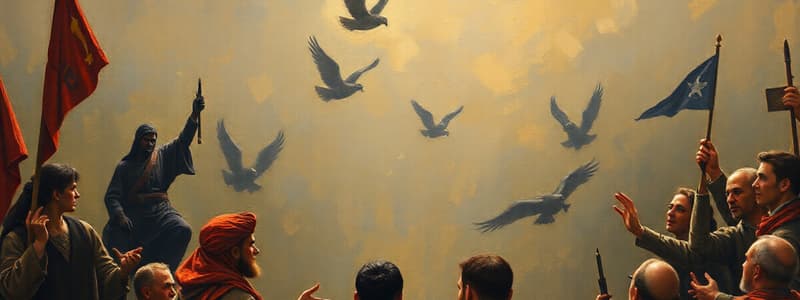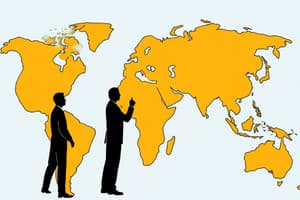Podcast
Questions and Answers
The Vietnam War began with the attack of two US warships in the Gulf of Tonkin by which country?
The Vietnam War began with the attack of two US warships in the Gulf of Tonkin by which country?
- China
- North Vietnam (correct)
- South Vietnam
- Soviet Union
Which of the following is NOT a key aspect of 'propaganda' as described in the content?
Which of the following is NOT a key aspect of 'propaganda' as described in the content?
- It uses one-sided ideas and images.
- It can be used to evoke strong emotions in people.
- It typically presents objective and balanced information. (correct)
- It aims to promote a specific cause.
The 'Iron Curtain' refers to:
The 'Iron Curtain' refers to:
- A specific military strategy used by the Soviet Union.
- A metaphor for the division between Western and Soviet-aligned countries. (correct)
- A physical barrier built by the Soviet Union.
- A policy of containing the spread of communism.
What was the primary goal of the 'Containment' policy?
What was the primary goal of the 'Containment' policy?
Which of the following best describes the 'Nonalignment' movement?
Which of the following best describes the 'Nonalignment' movement?
What was a key characteristic of 'Proxy Wars' during the Cold War?
What was a key characteristic of 'Proxy Wars' during the Cold War?
The Korean War was a conflict between:
The Korean War was a conflict between:
Which of the following is NOT a fundamental principle of 'Democracy' as described in the content?
Which of the following is NOT a fundamental principle of 'Democracy' as described in the content?
What was the main purpose of the Warsaw Pact?
What was the main purpose of the Warsaw Pact?
What was the significance of the Mujahideen in the Cold War?
What was the significance of the Mujahideen in the Cold War?
What is the 38th parallel?
What is the 38th parallel?
How did the War on Terror impact the use of drones?
How did the War on Terror impact the use of drones?
What is the main goal of ISIS?
What is the main goal of ISIS?
Why were child soldiers used in the Sierra Leone Civil War?
Why were child soldiers used in the Sierra Leone Civil War?
What is the definition of "blood diamonds"?
What is the definition of "blood diamonds"?
What is PTSD?
What is PTSD?
What was one of the major reasons for the long and violent conflict in Sierra Leone?
What was one of the major reasons for the long and violent conflict in Sierra Leone?
Flashcards
Propaganda
Propaganda
Biased information used to promote a political cause or point of view.
Nonalignment
Nonalignment
A group of states that were not formally aligned with or against any major power.
Democracy
Democracy
A form of government where the people choose their leader and make decisions.
Communism
Communism
Signup and view all the flashcards
Containment
Containment
Signup and view all the flashcards
Iron Curtain
Iron Curtain
Signup and view all the flashcards
Vietnam War
Vietnam War
Signup and view all the flashcards
Proxy Wars
Proxy Wars
Signup and view all the flashcards
Warsaw Pact
Warsaw Pact
Signup and view all the flashcards
NATO
NATO
Signup and view all the flashcards
Mujahideen
Mujahideen
Signup and view all the flashcards
38th parallel
38th parallel
Signup and view all the flashcards
Nuclear Proliferation
Nuclear Proliferation
Signup and view all the flashcards
War on Terror
War on Terror
Signup and view all the flashcards
Al-Qaeda
Al-Qaeda
Signup and view all the flashcards
Drone
Drone
Signup and view all the flashcards
Blood Diamonds
Blood Diamonds
Signup and view all the flashcards
Post-Traumatic Stress Disorder (PTSD)
Post-Traumatic Stress Disorder (PTSD)
Signup and view all the flashcards
Study Notes
Propaganda
- Definition: Biased information used to promote a political cause or viewpoint. This includes one-sided ideas and images meant to evoke emotions (like patriotism or fear) and persuade audiences.
- Significance: Used as a persuasive tactic and psychological weapon, particularly during wartime; leaders used it to boost morale.
Nonalignment
- Definition: A group of states that do not formally align themselves with a major global power. (Neutral)
- Significance: Intended to develop countries.
Democracy
- Definition: A form of government where citizens choose their leaders and make decisions.
- Significance: Used as a system of governance in various nations.
Communism
- Definition: A political theory advocating for economic equality, no social classes.
- Significance: Promoted as a type of government where all property is owned publicly, with the aim of achieving perfect equality; supported by Vladimir Lenin, becoming the system for the Soviet Union, North Korea, and North Vietnam. Its proponents viewed existing social class divisions as unjust.
Containment
- Definition: A policy to stop the spread of communism through financial and military aid to countries threatened by it.
- Significance: A key American strategy to limit communism's expansion during the Cold War.
Iron Curtain
- Definition: A political, military, and ideological barrier established by the Soviet Union to isolate its Eastern and Central European allies from the West.
- Significance: The Soviets used this barrier to isolate themselves from open contact with the West; Winston Churchill used the term metaphorically to explain the growing Soviet sphere of influence, highlighting the need for containment strategies.
Vietnam War
- Summary: Conflict in Vietnam, arising from the division of the country at the 17th parallel. The US supported South Vietnam while North Vietnam sought unification. The US withdrew in 1969.
- Details: Gulf of Tonkin incident involved US warships; US funding and support for South Vietnam.
Korean War
- Summary: North Korea invaded South Korea along the 38th parallel, aiming to unify the country. The conflict resulted in a division of the peninsula.
- Details: North Korea received Soviet support; opposing forces included South Korea, Soviet Union, and China; lasting division of the country was a result.
Proxy Wars
- Definition: Armed conflicts where third-party actors (other than the direct combatants) provide military and economic support to one side to influence the outcome.
- Significance: Provided a means for nations to engage in conflict without complete warfare, allowing them to act in support of their respective interests without full-scale engagement.
Warsaw Pact
- Definition: A political and military agreement between Eastern European nations aligned with the Soviet Union.
- Significance: Provided a collective military response among these nations toward perceived threats and alliances, primarily aiming to combat NATO's influence.
NATO
- Definition: The North Atlantic Treaty Organization; formed for collective defense against aggression.
- Significance: A collective defensive alliance.
Mujahideen
- Definition: Anti-communist fighters in Afghanistan.
- Significance: Supported by the U.S. to oppose the Soviet invasion, later becoming part of the Taliban. They used guerrilla tactics to oppose invading Soviet forces.
Kim Jung-Il
- Summary: Leader of North Korea with significant control over their military, defense forces. Declared supreme leader.
- Key details: Led the Korean People's Army, which is the fourth largest army in the world.
38th Parallel
- Definition: Line of latitude that divides North and South Korea.
- Significance: Originated during the Korean War and became a key division within the Korean Peninsula.
Zone (DMZ)
- Definition: Demilitarized Zone—a buffer area between North and South Korea.
- Significance: The original boundary between the two Koreas established after World War II.
Nuclear Proliferation
- Definition: The spread of nuclear weapons, technology, or materials to nations not already in possession of them.
- Significance: A concern due to the potential for increased conflict and the danger of more parties having such weapons.
Vladimir Putin
- Summary: Russian president who invaded Ukraine in 2022, motivated by challenges to recognition of Ukrainian statehood.
- Significance: His actions aimed to demilitarize and denazify Ukraine.
War on Terror
- Definition: A military campaign launched by the US in response to the September 11th attacks.
- Significance: Targeted Al-Qaeda, Taliban, and Ba'athist regimes.
Child Soldiers
- Significance: Used in conflicts (like in Sierra Leone) due to lower cost to recruit and train; often faced psychological trauma.
Al-Qaeda
- Definition: An Islamist terrorist organization founded by Osama bin Laden. Their motivation included perceived Western aggression and support for anti-Muslim actions.
- Significance: Responsible for the 9/11 attacks.
Drone
- Definition: Unmanned aerial vehicle used in military operations.
- Significance: Provides long-range surveillance and strike capabilities, reducing the need for immediate human presence in potentially dangerous situations.
Islamic State of Iraq and the Levant (ISIS)
- Definition: Extremist group aiming to create a caliphate governed by Islamic law.
- Significance: Seeks to establish Islamic rules, consolidate territory, and target civilians and governments.
Sierra Leone Civil War
- Summary: Protracted civil war in Sierra Leone stemming from the conflict over "blood diamonds."
- Key players: Sierra Leone Armed Forces (SLA), Revolutionary United Front (RUF), Liberian forces that were all involved with the conflict.
Hamas
- Definition: Palestinian Islamist organization that advocates for armed resistance against Israel, aiming to establish an Islamic state in Palestine.
- Significance: Recent actions include surprise attacks (October 2024) resulting in extensive casualties.
Blood Diamonds
- Definition: Diamonds mined in conflict zones and traded illegally for financial gain.
- Significance: Fueling conflicts in areas where diamonds are mined.
PTSD
- Definition: Post-Traumatic Stress Disorder; a mental health condition resulting from exposure to traumatic events.
- Significance: Common among soldiers and civilians experiencing conflict.
Studying That Suits You
Use AI to generate personalized quizzes and flashcards to suit your learning preferences.




